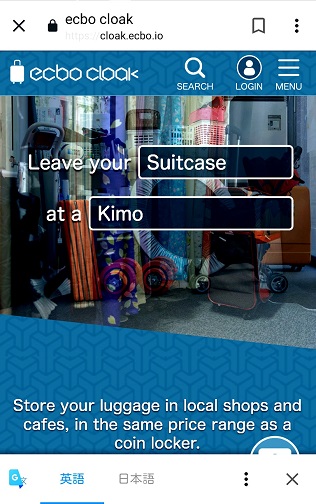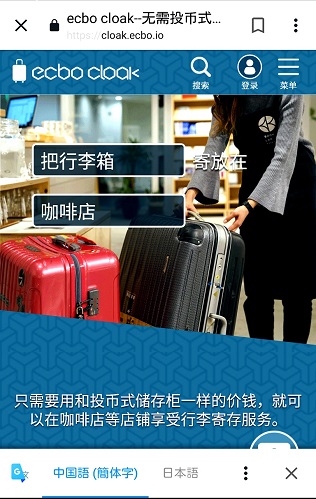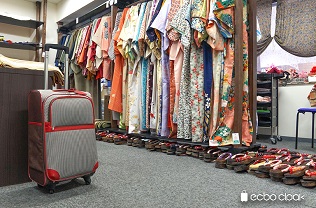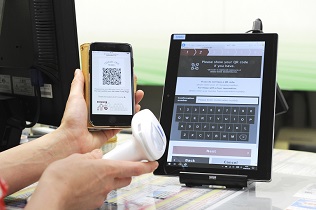Web Japan > Trends in Japan > Tech & Life > Various Japanese Cultivation Technologies Help to Overcome Environmental Conditions
“Hands-Free Sightseeing” for Relaxed Travel

Luggage storage services for foreign visitors are spreading across Japan (courtesy of ecbo)
Warmly welcoming travelers is at the heart of Japanese hospitality. When we see a foreign visitor doing sightseeing with luggage in both hands, we would like to help him or her enjoy the trip in a more relaxed manner. This wish has led to “hands-free sightseeing” services that offer foreign visitors to simply leave their luggage with them or have it shipped to a desired location. In this way, Japanese hospitality services provide for a more relaxed vacation.
Utilizing Empty Business Space
Luggage storage lockers at major train hubs like Tokyo station often fill up quickly. Large lockers able to fit a suitcase are particularly few in number compared to smaller ones for regularly-sized bags in the first place. This is one of the reasons for a rise in foreign travelers dragging large suitcases as they walk around town, for example when switching hotels.
In January 2017 a Japanese start-up initiated an effort to help such travelers. This sharing service offers “empty space” in established businesses such as restaurants as storage locations for luggage.
The process is simple: Users merely have to enter the necessary information (date and time of storage and pickup, storage location, luggage size and number, and customer name) in advance via the service’s website. Because travelers are able to secure a storage space via the internet before coming to Japan, they no longer have to walk around looking for storage lockers and be frustrated by the lack thereof. The service is offered in Japanese, English, Chinese (simplified and traditional), and Korean.
“ecbo” input screen. Registration is available in English (left), Chinese (traditional and simplified), and Korean (ecbo)
There are no bothersome procedures such as filling in forms or presenting identification during the storage and pickup process. It’s enough to show your smartphone screen. A picture of the luggage taken by phone or a QR code – the use of which recently has been spreading rapidly abroad as well – serve as “proof” for storage and pickup. Payment is completed by credit card.
Many foreign travelers visiting Japan are responding positively, saying that the process is uncomplicated, that they would use the service again, and that the service is no more expensive than a storage locker. Reportedly the number of users is steadily increasing.
Storing Businesses Benefit Too
The number of participating businesses serving as storage locations is over one thousand (as of December 6, 2018). The nature of such storage locations includes public facilities like train stations, post offices and tourist information centers, as well as restaurants and coffee shops, manga cafes, clothing stores, variety and electronics shops, real estate businesses, hair salons, and even Shinto shrines. These diverse locations are centered in the major cities of Sapporo, Tokyo, Nagoya, Osaka, Kyoto, Fukuoka, Matsuyama, and Okinawa, and are slated to expand further in the future.
Participating businesses of course register as storage locations because they are compensated for the space provided, but that’s not all they get in return. When foreign travelers visit a storage location, they may notice products and services offered by the business and become customers. One restaurant saw a higher number of foreign customers and increased sales after registering as a storage location. A hair salon even had a foreign traveler who decided to get a haircut there when visiting to store luggage.
Businesses benefit from their participation, such as through increased sales (courtesy of ecbo).
At temporary luggage storage facilities and forwarding services to travelers’ accommodation installed at locations like Tokyo station by major Japanese transportation companies, customers are welcomed by staff who wear traditional happi coats, which used to be worn as work clothes by Japanese artisans, in order to provide the customers with a pleasant sight.
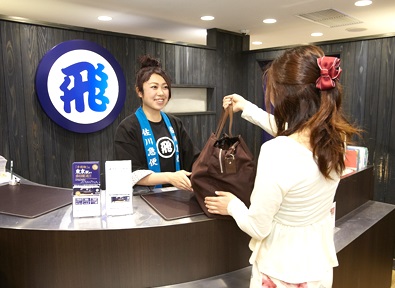
A staff member wearing a happi coat while handing over luggage at the Tokyo Service Center, located at Tokyo station. (courtesy of Sagawa Express)
Expanding Services
Japan’s major tourism agencies, in cooperation with major transportation companies, also started a new service in January 2018 to help foreign visitors to Japan with their hands-free sightseeing. Using these companies’ nationwide networks, the service offered by them forwards large pieces of luggage to travelers’ accommodation or the airport when arriving in Japan, moving around domestically, or leaving the country.
Users can access the service’s reservation portal with a PC or smartphone and request forwarding of their luggage. A QR code assigned to the luggage is then issued. When picking up the luggage, travelers show this QR code on their smartphone screen to staff at the airport counter or their accommodation to complete the process. The service features language support for Japanese, English, Chinese (traditional and simplified), Korean, Thai, Spanish, Italian, and French.
Luggage can be entrusted to the service at the four main airports of Narita, Haneda, Kansai, and Chubu, and foreign travelers can then enjoy hands-free sightseeing from the airport they landed at. Of course luggage can also be sent from one accommodation to the next when transferring domestically, or from an accommodation to the departure airport. The major agencies are planning to expand the number of regional airports offering this service in the future.
Japan’s Ministry of Land, Infrastructure, Transport and Tourism, which aims to increase the number of foreign visitors to Japan, in 2015 created a shared “hands-free sightseeing” logo in a bold red, so that foreign travelers can immediately recognize luggage storage spaces, as one element of the ministry’s promotion of hands-free sightseeing. The private enterprises offering luggage handling services for foreign travelers can display this logo at their reception counters and the like, as long as they are approved by the state. As of December 5, 2018, approved locations number 239. The staff whose smiles look like the accompanying logos look forward to foreign travelers arriving in Japan every day.

